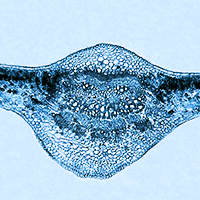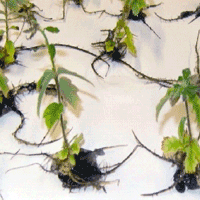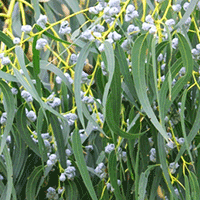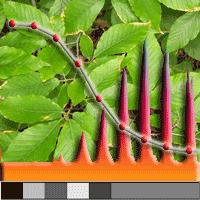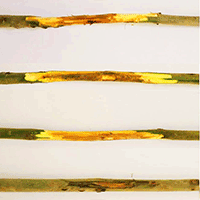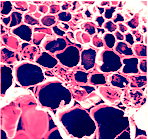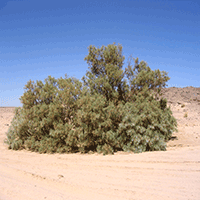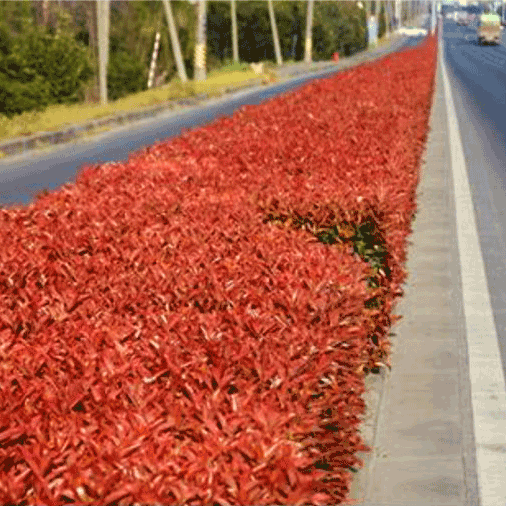Fast growing woody plants represent effective tools for cadmium (Cd) extraction during remediation of low to medium Cd contaminated soils. Poplars are good candidates for this task because of their rapid growth rate, high biomass yield, and adaptability, as well as the availability of well-characterized clones/ genotypes with various anatomical and physiological traits. The present study evaluates the potential of Populus deltoides (clone B-81) and Populus × euramericana (clone Pannonia) for phytoremediation of Cd contamination in soil. Poplar clones were analyzed for (1) plant growth response to Cd contamination, (2) Cd accumulation, translocation, and partitioning between plant organs, and (3) morphological, anatomical and physiological responses to Cd stress as a function of biomass production. Plants were cultivated in soil moderately contaminated with Cd (8.14 mg kg-1 soil) under semi-controlled conditions for six weeks. Our results suggest that P. × euramericana and P. deltoides clones respond differently to Cd contamination. Biomass production and morphological characteristics were more negatively affected in P. × euramericana than in P. deltoides plants. However, most examined leaf structural parameters were not significantly affected by Cd. In most cases, photosynthetic characteristics and gas exchange parameters were affected by Cd treatment, but the levels and patterns of changes depended on the clone. High tolerance to applied Cd levels, as estimated by the tolerance index, was observed in both clones, but was higher in P. deltoides than P. × euramericana (82.2 vs. 66.5, respectively). We suspect that the higher tolerance to Cd toxicity observed in P. deltoides could be related to unchanged proline content and undisturbed nitrogen metabolism. Following treatment, 58.0 and 46.7% of the total Cd content was accumulated in the roots of P. × euramericana and P. deltoides, respectively, with the remainder in the stems (18.2 and 39.9%) and leaves (23.8 and 13.4%). In summary, P. deltoides displayed better phytoextraction performance under Cd exposure than P. × euramericana, suggesting its potential not only for Cd phytostabilization, but also phytoextraction projects.
Keywords
, , , ,
Citation
Nikolić N, Zorić L, Cvetković I, Pajević S, Borišev M, Orlović S, Pilipović A (2017). Assessment of cadmium tolerance and phytoextraction ability in young Populus deltoides L. and Populus × euramericana plants through morpho-anatomical and physiological responses to growth in cadmium enriched soil. iForest 10: 635-644. - doi: 10.3832/ifor2165-010
Academic Editor
Claudia Cocozza
Paper history
Received: Jul 06, 2016
Accepted: Mar 30, 2017
First online: Jun 01, 2017
Publication Date: Jun 30, 2017
Publication Time: 2.10 months
© SISEF - The Italian Society of Silviculture and Forest Ecology 2017
Open Access
This article is distributed under the terms of the Creative Commons Attribution-Non Commercial 4.0 International (https://creativecommons.org/licenses/by-nc/4.0/), which permits unrestricted use, distribution, and reproduction in any medium, provided you give appropriate credit to the original author(s) and the source, provide a link to the Creative Commons license, and indicate if changes were made.

Breakdown by View Type
(Waiting for server response...)
Article Usage
Total Article Views: 50739
(from publication date up to now)
Breakdown by View Type
HTML Page Views: 40839
Abstract Page Views: 4233
PDF Downloads: 4356
Citation/Reference Downloads: 38
XML Downloads: 1273
Web Metrics
Days since publication: 3116
Overall contacts: 50739
Avg. contacts per week: 113.98
Article Citations
Article citations are based on data periodically collected from the Clarivate Web of Science web site
(last update: Mar 2025)
Total number of cites (since 2017): 31
Average cites per year: 3.44
Publication Metrics
by Dimensions ©
Articles citing this article
List of the papers citing this article based on CrossRef Cited-by.
(1)
Aasamaa K, Heinsoo K, Holm B (2010)Biomass production, water use and photosynthesis of
Salix clones in a wastewater purification system. Biomass and Bioenergy 34: 897-905.
CrossRef |
Gscholar
(2)
Akhter F, Macfie SM (2012)Species-specific relationship between transpiration and cadmium translocation in lettuce, barley and radish. Journal of Plant Studies 1: 1-13.
Gscholar
(3)
Al Afas N, Marron N, Ceulemans R (2007)Variability in
Populus leaf anatomy and morphology in relation to canopy position, biomass production, and varietal taxon. Annals of Forest Science 64: 521-532.
CrossRef |
Gscholar
(4)
Asgher M, Khan MIR, Iqbal N, Masood A, Khan NA (2013)Cadmium tolerance in mustard cultivars: dependence on proline accumulation and nitrogen assimilation. Journal of Functional and Environmental Botany 3: 30-42.
CrossRef |
Gscholar
(5)
Bates LS (1973)Rapid determination of free proline for water stress studies. Plant and Soil 39: 205-207.
CrossRef |
Gscholar
(6)
Bernardini A, Salvatori E, Guerrini V, Fusaro L, Canepari S, Manes F (2016a)Effects of high Zn and Pb concentrations on
Phragmites australis (Cav.) Trin. Ex. Steudel: photosynthetic performance and metal accumulation capacity under controlled conditions. International Journal of Phytoremediation 18: 16-24.
CrossRef |
Gscholar
(7)
Bernardini A, Salvatori E, Di Re S, Fusaro L, Nervo G, Manes F (2016b)Natural and commercial
Salix clones differ in their ecophysiological response to Zn stress. Photosynthetica 54: 56-64.
CrossRef |
Gscholar
(8)
Borowiak K, Gasecka M, Mleczek M, Dabrowski J, Chadzinikolau T, Magdziak Z, Golinski P, Rutkowski P, Kozubik T (2015)Photosynthetic activity in relation to chlorophylls, carbohydrates, phenolics and growth of a hybrid
Salix purpurea x triandra x viminalis 2 at various Zn concentrations. Acta Physiologiae Plantarum 37 (8): 599.
CrossRef |
Gscholar
(9)
Burzynski M, Zurek A (2007)Effects of copper and cadmium on photosynthesis in cucumber cotyledons. Photosynthetica 45: 239-244.
CrossRef |
Gscholar
(10)
Chaffei C, Pageau K, Suzuki A, Gouia H, Ghorbel MH, Masclaux-Daubresse C (2004)Cadmium toxicity induced changes in nitrogen management in
Lycopersicon esculentum leading to a metabolic safeguard through an amino acid storage strategy. Plant and Cell Physiology 45: 1681-1693.
CrossRef |
Gscholar
(11)
Dandekar AM, Uratsu SL (1988)A simple base pair change in proline biosynthesis genes causes osmotic stress tolerance. Journal of Bacteriology 170: 5943-5945.
CrossRef |
Gscholar
(12)
Djebali W, Zarrouk M, Brouquisse R, El Kahoui S, Liamam F, Ghorbel MH, Chaïbi W (2005)Ultrastructure and lipid alterations induced by cadmium in tomato (
Lycopersicon esculentum) chloroplast membranes. Plant Biology 7: 358-368.
CrossRef |
Gscholar
(13)
Ebbs S, Uchil S (2008)Cadmium and zinc induced chlorosis in Indian mustard [
Brassica juncea (L.) Czern] involves preferential loss of chlorophyll b. Photosynthetica 46: 49-55.
CrossRef |
Gscholar
(14)
European Union (2002)Heavy metals in wastes. Project ENV.E.3/ETU/2000/0058 Final Report, European Commission on Environment, DG ENV. E3, COWI A/S, Denmark, pp. 86.
Gscholar
(15)
Gill SS, Hasanuzzaman M, Nahar K, Macovei A, Tuteja N (2013)Importance of nitric oxide in cadmium stress tolerance in crop plants. Plant Physiology and Biochemistry 63: 254-261.
CrossRef |
Gscholar
(16)
Hageman RH, Reed AJ (1980)Nitrate reductase from higher plants. Methods in Enzimology 69: 270-279.
CrossRef |
Gscholar
(17)
He J, Ma C, Ma Y, Li H, Kang J, Liu T, Polle A, Peng C, Luo Z-B (2013)Cadmium tolerance in six poplar species. Environmental Science and Pollution Research 20: 163-174.
CrossRef |
Gscholar
(18)
Ivanova LA, P’yankov VI (2002)Structural adaptation of the leaf mesophyll to shading. Russian Journal of Plant Physiology 49: 419-431.
CrossRef |
Gscholar
(19)
Kawachi T, Shoji Y, Sugimoto T, Oji YL, Kleinhofs A, Warner RL, Ohtake N, Ohyama T, Sueioshi K (2002)Role of xylem sap nitrate in regulation of nitrate reductase gene expression in leaves of barley (
Hordeum vulgare L.) seedlings. Soil Science and Plant Nutrition 48: 79-85.
CrossRef |
Gscholar
(20)
Kitajima K, Hogan KP (2003)Increases of chlorophyll a/b ratios during acclimation of tropical woody seedlings to nitrogen limitation and high light. Plant, Cell and Environment 26: 857-865.
CrossRef |
Gscholar
(21)
Liu H, Wang H, Ma Y, Wang H, Shi Y (2016)Role of transpiration and metabolism in translocation and accumulation of cadmium in tobacco plants (
Nicotiana tabacum L.). Chemosphere 144: 1960-1965.
CrossRef |
Gscholar
(22)
Liu L, Sun H, Chen J, Zhang Y, Li D, Li C (2014)Effects of cadmium (Cd) on seedling growth traits and photosynthesis parameters in cotton (
Gossypium hirsutum L.). Plant Omics Journal 7 (4): 284-290.
Online |
Gscholar
(23)
Luković J, Merkulov L, Pajević S, Zorić L, Nikolić N, Borišev M, Karanović D (2012)Quantitative assessment of effects of cadmium on the histological structure of poplar and willow leaves. Water, Air and Soil Pollution 223: 2979-2993.
CrossRef |
Gscholar
(24)
Lunáčková L, Šottnikova A, Masarovičova E, Lux A, Streško V (2003)Comparison of cadmium effect on willow and poplar in response to different cultivation conditions. Biologia Plantarum 47: 403-411.
CrossRef |
Gscholar
(25)
Lux A, Martinka M, Vaculík M, White PJ (2011)Root responses to cadmium in the rhizosphere: a review. Journal of Experimental Botany 62: 21-37.
CrossRef |
Gscholar
(26)
Lux A, Sottníková A, Opatrná J, Greger M (2004)Differences in structure of adventitious roots in
Salix clones with contrasting characteristics of cadmium accumulation and sensitivity. Physiologia Plantarum 120: 537-545.
CrossRef |
Gscholar
(27)
Nazar R, Iqubal N, Masood A, Khan MIR, Syeed S, Khan NA (2012)Cadmium toxicity in plants and role of mineral nutrients in its alleviation. American Journal of Plant Sciences 3: 1476-1489.
CrossRef |
Gscholar
(28)
Nikolić N (2009)Effect of heavy metals on morpho-anatomical and physiological characteristics of poplar clones (
Populus spp.). PhD thesis, Faculty of Sciences, University of Novi Sad, Republic of Serbia, pp. 92-94.
Gscholar
(29)
Nikolić N, Kojić D, Pilipović A, Pajević S, Krstić B, Borišev M, Orlović S (2008)Responses of hybrid poplar to cadmium stress: photosynthetic characteristics, cadmium and proline accumulation, and antioxidant enzyme activity. Acta Biologica Croatica Series Botanica 50/2: 95-103.
Gscholar
(30)
Pajević S, Borišev M, Nikolić N, Krstić B, Pilipović A, Orlović S (2009)Phytoremediation capacity of poplar (
Populus spp.) and willow (
Salix spp.) clones in relation to photosynthesis. Archives of Biological Sciences 61: 239-247.
Online |
Gscholar
(31)
Parmar P, Kumari N, Sharma V (2013)Structural and functional alterations in photosynthetic apparatus of plants under cadmium stress. Botanical Studies 54: 45-50.
CrossRef |
Gscholar
(32)
Perfus-Barbeoch L, Leonhardt N, Vavasseur A, Forestier C (2002)Heavy metal toxicity: cadmium permeates through calcium channels and disturbs the plant water status. The Plant Journal 32: 539-548.
CrossRef |
Gscholar
(33)
Pietrini F, Zacchini M, Iori V, Pietrosanti L, Bianconi D, Massacci A (2010)Screening of poplar clones for cadmium phytoremediation using photosynthesis, biomass and cadmium content analyses. International Journal of Phytoremediation 12: 105-120.
CrossRef |
Gscholar
(34)
Sarwar N, Saifullah X, Malhi SS, Zia MH, Naeem A, Bibi S, Farid G (2010)Role of mineral nutrition in minimizing cadmium accumulation by plants. Journal of the Science of Food and Agriculture 90: 925-937.
CrossRef |
Gscholar
(35)
Sharma SS, Dietz KJ (2006)The significance of amino acids and amino acid-derived molecules in plant responses and adaptation to heavy metal stress. Journal of Experimental Botany 57: 711-726.
CrossRef |
Gscholar
(36)
Shi GR, Cai QS (2008)Photosynthetic and anatomic responses of peanut leaves to cadmium stress. Photosynthetica 46: 627-630.
CrossRef |
Gscholar
(37)
Stoláriková-Vaculíková M, Romeo S, Minnocci A, Luxová M, Vaculík M, Sebastiani L (2015)Anatomical, biochemical and morphological responses of poplar
Populus deltoides clone Lux to Zn excess. Environmental and Experimental Botany 109: 235-243.
CrossRef |
Gscholar
(38)
Tang Y, Bao Q, Tian G, Fu K (2015)Heavy metal cadmium tolerance on the growth characteristics of industrial hemp (
Cannabis sativa L.) in China. In: Proceedings of the “International Conference on Advances in Energy, Environment and Chemical Engineering (AEECE-2015)” (Chen S, Zhou S eds). Changsha (China) 26-27 Sept 2015. Atlantis Press, Amsterdam - Beijing - Paris, pp. 289-295.
Gscholar
(39)
Tognetti R, Cocozza C, Marchetti M (2013)Shaping the multifunctional tree: the use of Salicaceae in environmental restoration. iForest - Biogeosciences and Forestry 6 (1): 37-47.
CrossRef |
Gscholar
(40)
Vassilev A, Perez-Sanz A, Semane B, Carleer R, Vangrosveld J (2005)Cadmium accumulation and tolerance of two
Salix genotypes hydroponically grown in presence of cadmium. Journal of Plant Nutrition 28: 2159-2177.
CrossRef |
Gscholar
(41)
Von Wettstein D (1957)Chlorophyll-letale und der submikroskopische formwechsel der plastiden [Chlorophyll and the submicroscopic shape change of plastid]. Experimental Cell Research 12: 427-433. [in German]
CrossRef |
Gscholar
(42)
Wilkins DA (1978)The measurement of tolerance to edaphic factors by means of root growth. New Phytologist 80: 623-633.
CrossRef |
Gscholar
(43)
Zhang F, Wan X, Zhong Y (2014a)Nitrogen as an important detoxification factor to cadmium stress in poplar plants. Journal of Plant Interactions 9: 249-258.
CrossRef |
Gscholar
(44)
Zhang X, Gao B, Xia H (2014b)Effect of cadmium on growth, photosynthesis, mineral nutrition and metal accumulation of bana grass and vetiver grass. Ecotoxicology and Environmental Safety 106: 102-108.
CrossRef |
Gscholar
